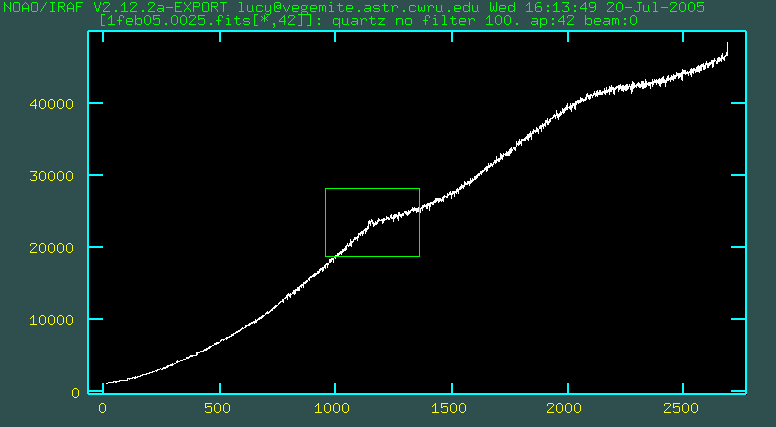
I used flatcombine first for flats without a filter, then for those with the cuso4 filter.
| noao.imred.ccdred.flatcombine |
|---|
I R A F
Image Reduction and Analysis Facility
PACKAGE = ccdred
TASK = flatcombine
input = @filterflats List of flat field images to combine
(output = Flat) Output flat field root name
|
I divided flats using imarith, imarith Flat / Flat2 Div (without filter / with filter)
Div does not have the dark spots found in all the flats. These are found at:
| x | y |
|---|---|
| 962.75 | 54.25 |
| 1447.25 | 203.75 |
| 1662.25 | 59.25 |
| 1655.25 | 76.25 |
| 1643.25 | 113.25 |
| 1827.75 | 122.25 |
| 1973.75 | 117.25 |
| 2102.75 | 112.25 |
| 2200.25 | 145.25 |
| 2200.25 | 145.25 |
| 2338.75 | 197.25 |
| 2565.75 | 68.25 |
| 2493.25 | 169.25 |
| 2606.25 | 139.25 |
The flatfields without a filter (Flat) has a weird bump (see below), so the flatfield with the filter (Flat2) will probably be used.

I use response to normalize each flatfield
| noao.twodspec.longslit.response |
|---|
I R A F |
The spots are back! I think this is a good thing? (yes, it is)
| noao.twodspec.longslit.response |
|---|
I R A F
Image Reduction and Analysis Facility
PACKAGE = longslit
TASK = response
calibrat= Flat Longslit calibration images
normaliz= Flat Normalization spectrum images
response= nFlat Response function images
(interac= yes) Fit normalization spectrum interactively?
(thresho= INDEF) Response threshold
(sample = *) Sample of points to use in fit
(naverag= 1) Number of points in sample averaging
(functio= spline3) Fitting function
(order = 13) Order of fitting function
(low_rej= 3.) Low rejection in sigma of fit
(high_re= 3.) High rejection in sigma of fit
(niterat= 1) Number of rejection iterations
(grow = 0.) Rejection growing radius
(graphic= stdgraph) Graphics output device
(cursor = ) Graphics cursor input
(mode = ql)
|
There are spots on this one also.
I used imarith to divide images, nFlat / nFlat2 nDiv
I then divided an individual flat by the combined flat, which made the spots disappear, so this means that they are not bad pixels; they just have a lower response.
I will use the normalized flat with filter, now renamed Flat.fits
I ran ccdproc again, changing the following parameters from when run for
zero correction.
(flatcor= yes) Apply flat field correction?
(flat = Flat) Flat field images
(interac= no) Fit overscan interactively?
(order = 4) Number of polynomial terms or spline pieces
(grow = 0.) Rejection growing radius